[1]
M.A. Levin, N.A. Fufaev, Deformable rolling wheel theory, first ed., Nauka, Moscow, (1989).
Google Scholar
[2]
UN GTR No. 8 - Electronic stability control systems (ECE/TRANS/180/Add. 8), the United Nations, (2008).
Google Scholar
[3]
V.I. Salnikov, Electronic stability control systems effectiveness evaluation, Automotive Industry. 10 (2013) 31-34.
Google Scholar
[4]
A.R. Wheeler, Computational tire models and their effectiveness, Engineering University of Arkansas, Fayetteville, AR, 2013, url: http: /uarkive. uark. edu/xmlui/bitstream/handle/10826/ ETD-2013-05-280/ WHEELER-THESIS. pdf.
Google Scholar
[5]
H.B. Pacejka, Semi-Empirical Tire Models, in: H.B. Pacejka, Tire and Vehicle Dynamics, second ed., SAE International, Oxford, 2006, pp.256-215.
DOI: 10.1016/b978-0-08-097016-5.00004-8
Google Scholar
[6]
A.J.C. Schmeitz, I.J.M. Besselink, J. de Hoogh and H. Nijmeijer, Extending the Magic Formula and SWIFT tire models for inflation pressure changes, International VDI Congress, Hannover (2005) 201-225.
Google Scholar
[7]
B. Beckman, The Magic Formula: Longitudinal Version, in: The Physics of Racing, Burbank, CA, 2001, pp.88-92, url: http: /phors. locost7. info/files/Beckman_-_The_Physics_of_Racing. pdf.
Google Scholar
[8]
Adams/Tire. Using the PAC2002Tire Model, url: http: /mech. unibg. it/~lorenzi/VD&S/Matlab/ Tire/tire_models_pac2002. pdf.
Google Scholar
[9]
B. Mashadi, H. Mousavi, M. Montazeri, Obtaining relations between the Magic Formula coefficients and tire physical properties, International Journal of Automotive Engineering, 1 vol. 5 (2015).
Google Scholar
[10]
M.Z. Burhaumudin, P.H. Samin, H. Jamaluddin, R.A. Rahman, S. Sulaiman, Modeling and Validation of Magic Formula Tire Model, International Conference on the automotive industry, mechanical and materials science (ICAMME'2012), Penang, (2012).
Google Scholar
[11]
G. Erdogan, Tire modeling lateral and longitudinal tire forces (lecture), 2009. url: http: /www. menet. umn. edu/~gurkan/Tire%20Modeling%20%20Lecture. pdf.
Google Scholar
[12]
Model Based Simulation. Flat Belt Tire Testing Rig (Catalog), (2012).
Google Scholar
[13]
Tyrosafe. Report on state-of-the-art of test methods, (2008).
Google Scholar
[14]
E.M. Kasprzak K.E. Lewis, D.L. Milliken, Inflation Pressure Effects in the Nondimensional Tire Model, Motorsports Engineering Conference & Exposition, SAE International, Buffalo, (2006).
DOI: 10.4271/2006-01-3607
Google Scholar
[15]
W.F. Millikan and D.L. Milliken, The dynamics of the race car vehicle, SAE International, Warrendale, PA, (1995).
Google Scholar
[16]
M. Mizuno, Development of tire side force model based on Magic Formula, with the influence of tire surface temperature, R&D Review of Toyota CRDL 4 vol. 38 (2003) 17-22, url: http: /www. tytlabs. com/japanese/review/rev384pdf/384_017mizuno. pdf.
Google Scholar
[17]
Tire Care and Maintenance, URL: http: /www. bridgestone. com/products/speciality_ tires/aircraft/candm/pdf/care_and_maintenance. pdf (accessed 28. 02. 2017).
Google Scholar
[18]
M.L. Janssen and G.L. Hall, Influence of ambient temperature on the Radial tire rolling resistance, Congress and Exposition Cobo Hall, SAE International, Detroit, (1980).
DOI: 10.4271/800090
Google Scholar
[19]
Continental SportContact 6. Workshop: Technologies for perfect GRIP, url: http: /blobs. continental-tires. com/www8/servlet/blob/484032/0e5a58822a3ccbf0b7c389fb62384d99/2015-09-02-pdf-4-data. pdf (accessed 28. 02. 2017).
Google Scholar
[20]
U.M. Lahtin, V.P. Leontieva, Materials science. Higher education textbook for students, - third ed., Mashinostroenie, Moscow, (1990).
Google Scholar
[21]
Extra-Deep-Tread Tires Lateral Stiffness Effects (technical bulletin), (1995), url: http: /commercial. firestone. com/content/dam/bcs-sites/firestone/TBR/technical-bulletins/ FS_TBR_tech -byk-ExtraDeepTreadTiresLateralStiffnessEffects_9510.
Google Scholar
[22]
S.I. Medveditskov, V.V. Kuzminov, Experimental studies of the influence of the passenger cars tires wear on wheel stabilizing moment under test-bench conditions, Proceedings of Volgograd State Technical University, Volgograd, 146 vol. 9 (2014).
Google Scholar
[23]
S.I. Medveditskov, R.S. Vardanian, Study of tire slippage change vs. its wear relation/ Mechanics of machines, mechanisms and materials, Minsk, 24 (2013).
Google Scholar


